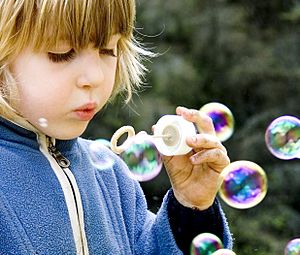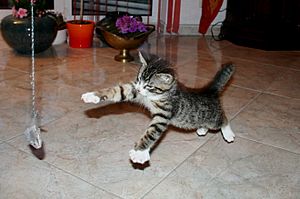Play (activity) facts for kids
Play is a fun and voluntary activity. It's something we do because we enjoy it, and it helps us learn. While we often think of play with children, it's also important for adults and many animals.
Many famous thinkers in psychology, like William James, Sigmund Freud, Carl Jung, Jean Piaget, and Lev Vygotsky, believed that play is a natural part of being human. Play can be lighthearted and spontaneous, or it can be very focused, like when you're deeply involved in a game.
Why Do We Play?
Scientists have studied play in animals and found it's hard to define exactly. But play is very common in young mammals, and also in some birds like parrots and ravens. This means play must have an important purpose, even if it doesn't help with immediate survival. In fact, young animals sometimes even risk danger when they play!
Even though it seems risky, play helps animals survive in the long run. This idea is a bit of a puzzle, but it suggests that play helps young animals learn skills they'll need as adults. This idea was first suggested by Karl Groos over a hundred years ago, and it's still a popular explanation today.
How to Spot Play
It can be tricky to tell if an animal's behavior is truly play. Konrad Lorenz, a famous animal behavior expert, came up with a way to tell. He said that play should look different from the real thing.
For example, when young puppies play-fight, it's not the same as a serious dog fight. The main difference is that in play, animals still hold back. They don't really try to hurt each other. Lorenz explained that even in the most energetic play, animals keep their social rules, especially the rule against real biting.
Children's Play
Children's play can take many forms. It can be:
- Improvisation or pretend play: Making things up as you go.
- Performance: Acting things out.
- Mimicry: Copying others.
- Games: Activities with rules and goals.
- Sports: Organized games, often with teams.
Some play is structured, meaning it has rules and goals, like a game. Other play is unstructured, meaning there are no rules. Experts like Iona and Peter Opie studied many traditional children's games in England after World War II.
Often, sports with specific rules happen in special places, like sports fields. Other play areas might be playgrounds with equipment for active and social play. Some play spaces are indoors, like in museums or family entertainment centers.
The National Institute for Play describes seven types of play:
- Attunement play: This type of play helps people connect, like a baby and its mother.
- Body play: This is when a child explores how their body works and interacts with the world. For example, making funny sounds or learning what happens when they fall.
- Object play: This involves playing with toys, banging pots, or handling things in ways that show curiosity.
- Social play: This is play that involves other people. Examples include tumbling, making funny faces, and connecting with other children.
- Imaginative play (also called "pretend" or "fantasy"): Here, a child invents stories and acts them out in their dream world, like pretending to be a princess or a pirate.
- Storytelling play (or narrative play): This type of play helps with learning and language. It could be a parent reading to a child, or a child retelling a story in their own words.
- Creative play: This means using imagination to create new ideas or things. For example, a musician might experiment to find a new way to play an instrument. Or, like Albert Einstein, a person might wonder about unknown things and play with new ideas to discover knowledge.
Jean Piaget had his own way of looking at play:
- Games of mastery: These involve building, copying, or designing things.
- Games with rules: These include games like marbles, war games, or hide-and-seek.
- Games of make-believe and fantasy: These are about pretending and using imagination.
Sometimes, play is used by therapists to help children. This is called play therapy, and it helps kids who have gone through difficult experiences or have emotional problems.
Images for kids
-
Playfulness by Paul Manship
-
Children's Games, 1560, by Pieter Bruegel the Elder
-
Playing weiqi in Shanghai
See also
 In Spanish: Juego (recreación) para niños
In Spanish: Juego (recreación) para niños










